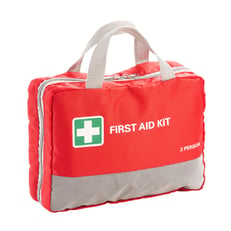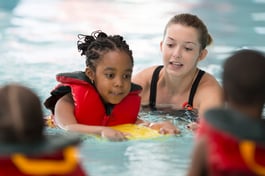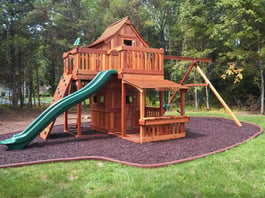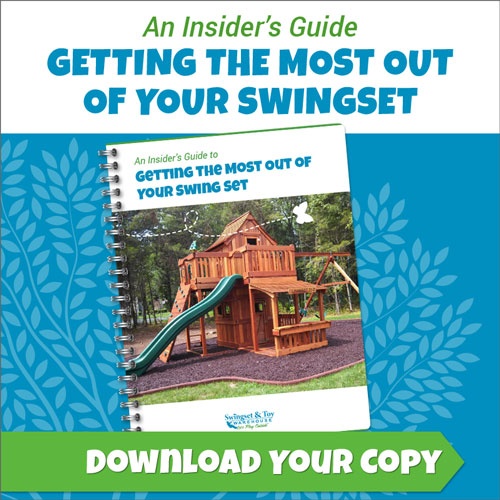
When you think about your childhood summers, what do you remember?
Trips to the beach? Learning to swim? Seeing how high you could swing on your wooden swing set?
We’re willing to bet that mixed in with those pleasant memories are a few standard injuries. The time you fell off your bike, or the day you accidentally wandered underneath a bee hive.
It’s hard to get through childhood without collecting your share of bumps and scrapes, but that doesn’t mean that parents shouldn’t be careful.
Summer vacation is just a few weeks away, so we thought we’d turn to the parents at Parents magazine for a few ways you can keep your kids safe once school lets out.
1. Have a first-aid kit handy
 No matter what the season, no home is complete without a first aid kit that includes:
No matter what the season, no home is complete without a first aid kit that includes:
- Band-aids, gauze and adhesive tape
- Antibacterial foam/gel
- Cold packs
- Tweezers
- Infant and children’s pain relievers
- Rubbing alcohol
- Hydrocortisone cream and triple anti-biotic ointment
In addition, you may want to include some soap, washcloths and a thermometer. You can’t stop accidents from happening, but you can be ready for when they do.
2. Keeping cool
 Summer time means spending a lot of time outside in hot temperatures. That’s when you need to have the signs of heat exhaustion on your radar: fatigue, muscle cramping and extreme thirst.
Summer time means spending a lot of time outside in hot temperatures. That’s when you need to have the signs of heat exhaustion on your radar: fatigue, muscle cramping and extreme thirst.
If left unchecked, heat exhaustion can turn into the far more serious heat stroke, symptoms of which include nausea, vomiting, dizziness, headaches and an inability to sweat, even on hot days.
If your kids demonstrate these symptoms, spray them with cold water from a hose or bottle and get them into a shady place. Applying ice packs to the armpits and groin can help them cool down even faster. Call 911 if you think your child is suffering from heat stroke.
3. Too young to swim?
 According to the American Academy of Pediatrics, kids aren’t ready to start formal swimming lessons until after they’ve turned 4.
According to the American Academy of Pediatrics, kids aren’t ready to start formal swimming lessons until after they’ve turned 4.
We realize that your kids might have begun swimming lessons as preschoolers or even infants, but the AAP warns that kids under four “cannot voluntarily hold their breath for significant amounts of time.” Whenever small children are in the water – even shallow water – make sure they are within arm’s reach.
If you want to outfit your child with a floatation device, go with a child-size life vest, which is a more reliable choice than water rings or swim rings. Consult with your local Red Cross chapter about taking CPR courses so you’ll prepared for the worst.
4. Battling bee stings
 Bees may be beneficial to your garden, but that doesn’t mean you want them around your kids. Floral patterned clothing, fragrances and open food/drink containers are all bee magnets.
Bees may be beneficial to your garden, but that doesn’t mean you want them around your kids. Floral patterned clothing, fragrances and open food/drink containers are all bee magnets.
If your child does get stung, use the edge of a credit card to brush away the stinger. From there, use a salve made from four parts water and one-part meat tenderizer to neutralize the venom. Apply the salve and let it rest for 30 minutes.
Next, apply cold compresses and hydrocortisone cream – there’s a reason you need that first aid kit – and give your child an oral antihistamine to reduce swelling.
5. Keeping other bugs at bay
When your kids play outside, check them for ticks upon their return. Choose bug repellents that contain DEET for maximum effectiveness. Products that have a DEET concentration of under 30 percent are safe for kids, but not for babies under 2 months old.
6. Safety on your wooden swing sets
 Summer is prime swing set season, and we want your kids to get the most out of their wooden swing sets while still being safe.
Summer is prime swing set season, and we want your kids to get the most out of their wooden swing sets while still being safe.
Wooden swing set safety includes:
- Using good materials, such as cedar and redwood, which are naturally resilient in the face of decay or rot.
- Making sure the swing set is placed somewhere you can see it from your house.
- Putting down protective playground surfacing such as sand or shredded rubber mulch, which will prevent injuries and protect your lawn.
- Inspecting your swing set on a regular basis, checking for signs of wear and tear, and tightening nuts and bolts. Consult with your swing set installer when it comes to larger maintenance issues.
Is this the summer you install a wooden swing set in your yard? Turn to Swingset & Toy Warehouse. Our four New Jersey locations offer a wide range of cedar and redwood playgrounds designed to fit any backyard and any budget.
Visit us online or at one of our stores to find the set that’s right for you. Have a safe and happy summer!



